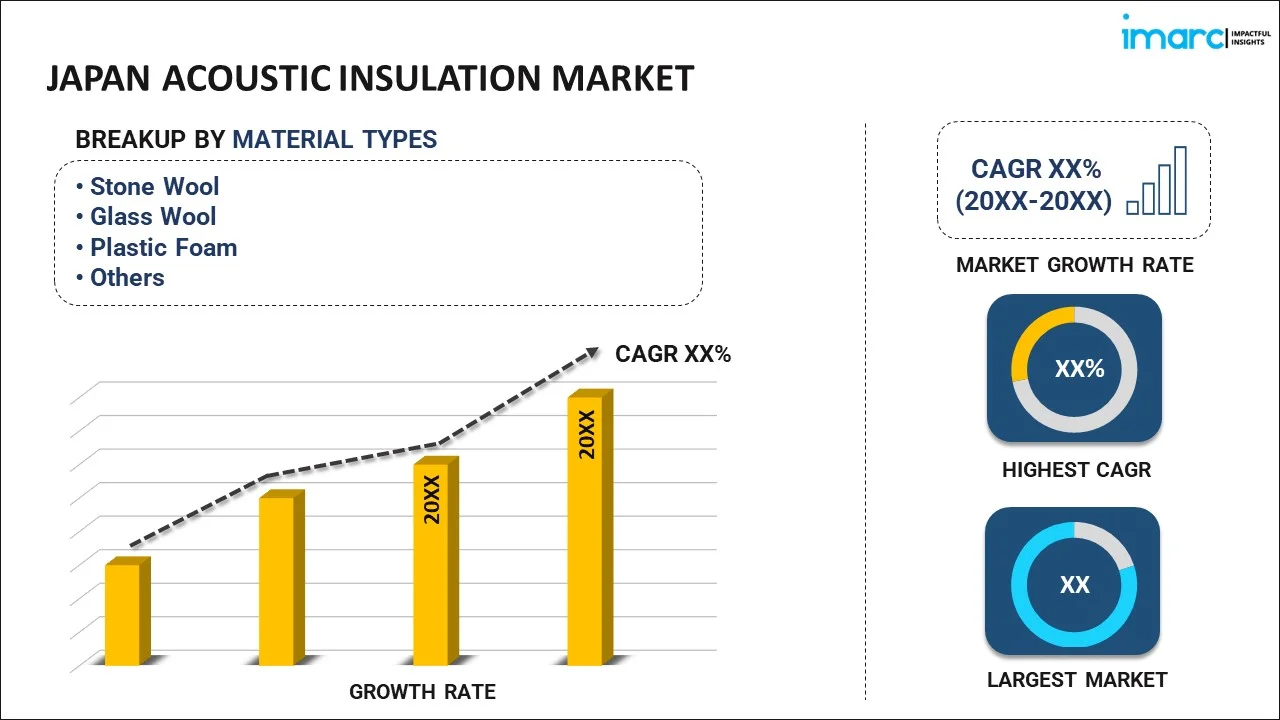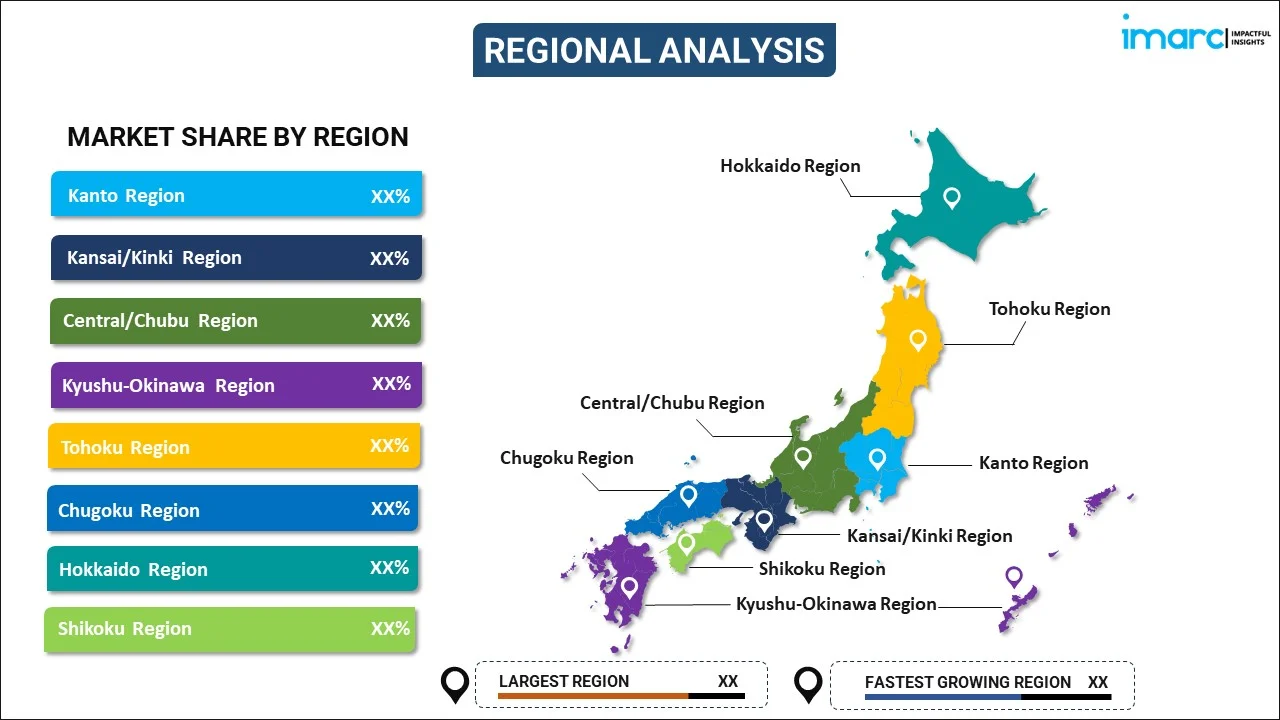
Japan Acoustic Insulation Market Report by Material Type (Stone Wool, Glass Wool, Plastic Foam, and Others), Sales Channel (Offline, Online), End User (Building and Construction, Industrial, Transportation), and Region 2025-2033
Market Overview:
Japan acoustic insulation market size reached USD 541.7 Million in 2024. Looking forward, IMARC Group expects the market to reach USD 892.1 Million by 2033, exhibiting a growth rate (CAGR) of 5.2% during 2025-2033. The growing industries and commercial enterprises, which often require specialized acoustic solutions to meet noise control requirements, particularly in sectors like manufacturing, entertainment, and hospitality, are driving the market.
|
Report Attribute
|
Key Statistics
|
|---|---|
|
Base Year
|
2024 |
|
Forecast Years
|
2025-2033
|
|
Historical Years
|
2019-2024
|
| Market Size in 2024 | USD 541.7 Million |
| Market Forecast in 2033 | USD 892.1 Million |
| Market Growth Rate (2025-2033) | 5.2% |
Acoustic insulation, often referred to as sound insulation or soundproofing, is a method of reducing the transmission of sound from one area to another. It involves the use of materials and techniques designed to block, absorb, or dampen sound waves, thereby minimizing the impact of noise on a particular space. Effective acoustic insulation is crucial in various settings, such as residential buildings, commercial spaces, and industrial facilities, where unwanted noise can be a significant disturbance. It helps create a more comfortable and productive environment by preventing the intrusion of external noise or containing sound within a specific area. Common materials used for acoustic insulation include dense barriers, acoustic panels, acoustic foam, and acoustic seals. These materials are strategically placed in walls, ceilings, floors, and doors to create a sound-resistant barrier. The effectiveness of acoustic insulation depends on factors like material quality, installation techniques, and the specific requirements of the space.
Japan Acoustic Insulation Market Trends:
The acoustic insulation market in Japan is experiencing robust growth due to several key drivers that are interconnected. Firstly, the rising urbanization rates have led to an increase in construction activities, resulting in a greater demand for acoustic insulation materials. Additionally, stringent government regulations on noise pollution have pushed construction and manufacturing industries to invest in soundproofing solutions, further boosting the market. Moreover, the growing awareness of the adverse health effects of noise pollution, such as stress and sleep disturbances, has prompted individuals and businesses to invest in acoustic insulation to create quieter and more comfortable environments. Simultaneously, advancements in technology and materials have made acoustic insulation products more effective and cost-efficient, making them a more attractive option for various applications. Furthermore, the emerging trend toward sustainable and eco-friendly construction practices, which utilize acoustic insulation materials that are both effective and environmentally friendly, is expected to drive the acoustic insulation market in Japan during the forecast period.
Japan Acoustic Insulation Market Segmentation:
IMARC Group provides an analysis of the key trends in each segment of the market, along with forecasts at the country level for 2025-2033. Our report has categorized the market based on material type, sales channel, and end user.
Material Type Insights:

- Stone Wool
- Glass Wool
- Plastic Foam
- Others
The report has provided a detailed breakup and analysis of the market based on the material type. This includes stone wool, glass wool, plastic foam, and others.
Sales Channel Insights:
- Offline
- Online
A detailed breakup and analysis of the market based on the sales channel have also been provided in the report. This includes offline and online.
End User Insights:
- Building and Construction
- Industrial
- Transportation
The report has provided a detailed breakup and analysis of the market based on the end user. This includes building and construction, industrial, and transportation.
Regional Insights:

- Kanto Region
- Kansai/Kinki Region
- Central/ Chubu Region
- Kyushu-Okinawa Region
- Tohoku Region
- Chugoku Region
- Hokkaido Region
- Shikoku Region
The report has also provided a comprehensive analysis of all the major regional markets, which include Kanto Region, Kansai/Kinki Region, Central/ Chubu Region, Kyushu-Okinawa Region, Tohoku Region, Chugoku Region, Hokkaido Region, and Shikoku Region.
Competitive Landscape:
The market research report has also provided a comprehensive analysis of the competitive landscape in the market. Competitive analysis such as market structure, key player positioning, top winning strategies, competitive dashboard, and company evaluation quadrant has been covered in the report. Also, detailed profiles of all major companies have been provided.
Japan Acoustic Insulation Market Report Coverage:
| Report Features | Details |
|---|---|
| Base Year of the Analysis | 2024 |
| Historical Period | 2019-2024 |
| Forecast Period | 2025-2033 |
| Units | Million USD |
| Scope of the Report | Exploration of Historical and Forecast Trends, Industry Catalysts and Challenges, Segment-Wise Historical and Predictive Market Assessment:
|
| Material Types Covered | Stone Wool, Glass Wool, Plastic Foam, Others |
| Sales Channels Covered | Offline, Online |
| End Users Covered | Building and Construction, Industrial, Transportation |
| Regions Covered | Kanto Region, Kansai/Kinki Region, Central/ Chubu Region, Kyushu-Okinawa Region, Tohoku Region, Chugoku Region, Hokkaido Region, Shikoku Region |
| Customization Scope | 10% Free Customization |
| Post-Sale Analyst Support | 10-12 Weeks |
| Delivery Format | PDF and Excel through Email (We can also provide the editable version of the report in PPT/Word format on special request) |
Key Questions Answered in This Report:
- How has the Japan acoustic insulation market performed so far and how will it perform in the coming years?
- What has been the impact of COVID-19 on the Japan acoustic insulation market?
- What is the breakup of the Japan acoustic insulation market on the basis of material type?
- What is the breakup of the Japan acoustic insulation market on the basis of sales channel?
- What is the breakup of the Japan acoustic insulation market on the basis of end user?
- What are the various stages in the value chain of the Japan acoustic insulation market?
- What are the key driving factors and challenges in the Japan acoustic insulation?
- What is the structure of the Japan acoustic insulation market and who are the key players?
- What is the degree of competition in the Japan acoustic insulation market?
Key Benefits for Stakeholders:
- IMARC’s industry report offers a comprehensive quantitative analysis of various market segments, historical and current market trends, market forecasts, and dynamics of the Japan acoustic insulation market from 2019-2033.
- The research report provides the latest information on the market drivers, challenges, and opportunities in the Japan acoustic insulation market.
- Porter's five forces analysis assist stakeholders in assessing the impact of new entrants, competitive rivalry, supplier power, buyer power, and the threat of substitution. It helps stakeholders to analyze the level of competition within the Japan acoustic insulation industry and its attractiveness.
- Competitive landscape allows stakeholders to understand their competitive environment and provides an insight into the current positions of key players in the market.
Need more help?
- Speak to our experienced analysts for insights on the current market scenarios.
- Include additional segments and countries to customize the report as per your requirement.
- Gain an unparalleled competitive advantage in your domain by understanding how to utilize the report and positively impacting your operations and revenue.
- For further assistance, please connect with our analysts.
 Inquire Before Buying
Inquire Before Buying
 Speak to an Analyst
Speak to an Analyst
 Request Brochure
Request Brochure
 Request Customization
Request Customization




.webp)




.webp)












